1. Overview
Yamanaka Yukimori, also widely known as Yamanaka Shikanosuke (山中 鹿の介Japanese), was a prominent Japanese samurai warrior who lived during the Sengoku period and Azuchi-Momoyama period. He served the Amago clan of Izumo Province with unwavering loyalty, even after their downfall. Renowned for his exceptional bravery and strategic acumen, he earned the moniker "Kirinji of San'in" (山陰の麒麟児Japanese, "Unicorn Child of San'in"). He is celebrated as the foremost among the Amago Ten Braves and one of the Amago Three Greats.
Yukimori is famously associated with the legend of his prayer to the crescent moon, where he implored, "I would rather sustain all kinds of troubles myself than see the clan of my lord fall into ruin," seeking to endure "seven difficulties and eight pains" (七難八苦Japanese, meaning all kinds of hardships) for the sake of his lord's restoration. This enduring tale, coupled with his persistent efforts to revive the Amago clan against overwhelming odds, cemented his legacy as a tragic hero and a symbol of ultimate loyalty in Japanese history. His helmet is conventionally depicted with a crescent moon ornament, a symbol of good luck, as he was said to have been born under a harvest moon.
2. Early Life and Background
Yamanaka Yukimori's early life is shrouded in some historical uncertainty due to a lack of definitive records. According to common belief, he was born on September 20, 1545, in Tomita-shō, Izumo Province (present-day Hirose-cho, Yasugi, Shimane Prefecture), at the foot of Gassantoda Castle.
The Yamanaka family's lineage is also subject to various theories. Several family trees exist, with a prominent theory suggesting they were a branch of the Sasaki clan (Kyōgoku clan), descendants of the Uda Genji line, and thus a family closely related to the Amago clan. Yamanaka Yukihisa, a younger brother of Amago Kiyosada, is considered their ancestor, and Yukimori is believed to be his fourth or sixth-generation descendant. Although the Yamanaka family served as a senior retainer of the Amago clan, Yukimori's father, Yamanaka Mitsuyuki, died young, leaving the family in poverty.
Yukimori was raised solely by his wise mother, Nami. She was known for her exceptional wisdom, often compared to the mothers of Cui Yuanhui and Lü Ronggong. Despite their impoverished circumstances, Nami diligently cultivated hemp in the fields to make clothes for Yukimori, while she herself wore tattered garments. She also extended her kindness to other poor children, providing them with clothes, food, and shelter. These children, grateful for her generosity, later grew up to support Yukimori in his endeavors. Nami imparted crucial lessons to her son, teaching him to share both successes and failures with his followers, to never abandon his troops in defeat, and to avoid monopolizing the praise for victories. It is said that Yukimori never forgot these teachings throughout his life.
From a young age, Yukimori dedicated himself to serving the Amago clan. He demonstrated remarkable martial prowess early on, reportedly killing an enemy at the tender age of eight. By the age of ten, he began studying mounted archery and military tactics. At thirteen, he achieved the notable feat of taking an enemy soldier's head in battle. At sixteen, he accompanied his lord, Amago Yoshihisa, in the siege of Odaka Castle in Hōki Province. During this campaign, he engaged and defeated Kikuchi Onehachi, a renowned warrior from Inaba and Hōki provinces, in a one-on-one duel.
As the second son, Yukimori was temporarily adopted into the Kamei clan, an important retainer family of the Amago. He even used the Kamei surname for a period. However, he later returned to the Yamanaka family and succeeded his elder brother, Yamanaka Yukitaka, as the family head.
3. Service to the Amago Clan
Yamanaka Yukimori's early military career was marked by his unwavering dedication to the Amago clan, engaging in numerous battles as the clan faced increasing pressure from the formidable Mōri clan. His first recorded military exploit occurred at the age of eight when he killed an enemy. By the age of thirteen, he had already achieved the feat of taking an enemy's head, demonstrating his innate martial talent.
At sixteen, Yukimori accompanied his lord, Amago Yoshihisa, in the siege of Odaka Castle in Hōki Province. During this campaign, he famously engaged and defeated Kikuchi Onehachi, a renowned warrior from Inaba and Hōki provinces, in a one-on-one duel, solidifying his reputation for bravery. This early success led him to pray to the crescent moon, asking for thirty days to achieve military glory, a prayer that was answered with his victory over Kikuchi Onehachi. From that point forward, he is said to have worshipped the crescent moon throughout his life.
His steadfast loyalty was evident throughout the Amago clan's decline. He supported Amago Katsuhisa against the Mori clan during the Siege of Gassantoda Castle in 1569, which included the Battle of Fubeyama in 1570. Even as the Amago clan's fortunes waned, Yukimori remained a pivotal figure, consistently fighting to protect his lords and their territories.
4. The Fall of the Amago Clan
The decline of the Amago clan began in earnest with the death of their lord, Amago Haruhisa, on January 9, 1561. His successor, Amago Yoshihisa, inherited a weakened domain and made critical diplomatic errors, such as failing to actively resist the Mori clan's invasion of Iwami Province in 1561, which led to many Amago-aligned local lords abandoning them or joining the Mori.
In August 1562, the Mori clan, led by Mōri Motonari, launched a full-scale invasion of Izumo Province to destroy the Amago clan. Having previously defeated Sue Harukata at the Battle of Miyajima in 1555 and destroyed the Ōuchi clan in 1557, the Mori had become the dominant power in the Chūgoku region. They systematically subjugated Amago-aligned local lords as they advanced, establishing their main camp at Aragi (Arai) in January 1563 to intensify their assault on the Amago's main stronghold, Gassantoda Castle.
On August 31, 1563, the Mori army attacked Shiraga Castle, considered the most important of the Amago Ten Flags, a crucial strategic point connecting the Shimane Peninsula to Gassantoda Castle and vital for securing supply routes. On October 8, the Amago clan dispatched a relief force led by Amago Tomohisa, with Yamanaka Yukimori accompanying them. The Mori army emerged victorious in the Siege of Shiraga Castle, forcing the Amago forces to retreat to Gassantoda Castle. During this retreat, Yukimori, commanding approximately 200 soldiers, served as the rear guard. He repelled the pursuing forces of Kikkawa Motoharu and Kobayakawa Takakage seven times, personally taking seven enemy heads. Shiraga Castle fell by mid-October 1563.
In 1564, the Amago army, including Yukimori, fought the Mori forces led by Sugihara Morishige at Mihonoseki and Yumigahama in the Battle of Yumigahama. Although the Amago won this battle, their subsequent defeat at Odaka Castle, another vital stronghold in Hōki Province, led to the Mori's complete control of Hōki. With their supply lines severed, Gassantoda Castle became completely isolated.
In May 1565, the Mori army established its main camp at Hoshigami-yama, about 1.9 mile (3 km) northwest of Gassantoda Castle, and began a full-scale assault. On May 16, the Mori launched a general attack on Gassantoda Castle (the Second Siege of Gassantoda Castle). Yukimori fiercely defended the Shiotani entrance, one of the three main approaches to the castle, repelling the forces of Kikkawa Motoharu. During this battle, Yukimori defeated Takano Kenmotsu in a single combat. On May 27, the Mori army, unable to capture the castle, retreated approximately 16 mile (25 km) to Aragi Castle.
In September, the Mori again attacked Gassantoda Castle. During this campaign, Yukimori famously engaged and defeated Shinagawa Shoin in a one-on-one duel. Also that month, Yukimori launched a night raid on the Mori forces led by Ogawauchi Yukitsuna, who were stationed in Shirakata (present-day Matsue, Shimane Prefecture), killing numerous soldiers.
On June 11, 1566, the Mori army launched a third general assault on Gassantoda Castle, but again failed to capture it. By January 1, 1567, the castle's provisions were severely depleted, and desertions among the troops were rampant. Recognizing that further resistance was futile, Amago Yoshihisa offered to surrender to the Mori. On January 8, Yoshihisa handed over the castle. At the time of the surrender, only 134 Amago retainers remained loyal to Yoshihisa. This marked the temporary downfall of the Sengoku-period Amago clan. Yoshihisa and his two brothers, Hidehisa and Tomohisa, along with a small number of followers, were taken to Enmyōji Temple in Aki Province and confined. Yukimori requested to accompany his lord but was denied, parting ways with Yoshihisa at Izumo Taisha Shrine. From that point on, Yukimori dedicated himself to the arduous task of restoring the Amago clan.
5. Amago Restoration Movement
Yamanaka Yukimori's efforts to restore the Amago clan were a relentless series of campaigns and political maneuvers, typically divided into three distinct phases. These movements were characterized by his unwavering loyalty and strategic brilliance against the overwhelming power of the Mori clan.
5.1. First Restoration Attempt
After the fall of the Amago clan, Yukimori became a rōnin. His movements between 1566 and 1568 are not precisely known. According to various accounts, he first recuperated from his wounds at Arima Onsen before traveling eastward as a pilgrim. During this period, he is said to have studied military strategies of prominent clans such as the Takeda clan (under Takeda Shingen), the Nagao clan (under Uesugi Kenshin), and the Later Hōjō clan (under Hōjō Ujiyasu). He also reportedly investigated the customs of the Asakura clan in Echizen Province before returning to Kyoto.
In 1568, Yukimori, along with other former Amago retainers such as Tachihara Hisatsuna, located Amago Katsuhisa, the orphaned son of Amago Masahisa, who was then a monk at Tōfuku-ji Temple in Kyoto. They persuaded Katsuhisa to return to secular life (還俗Japanese, *genzoku*) and secretly began gathering former Amago retainers, awaiting an opportunity for restoration.
In May 1569, Mōri Motonari dispatched his forces to northern Kyushu to attack the Ōtomo clan. Seizing this opportune moment, Yukimori initiated an invasion of Izumo Province. The Amago restoration army received support from Yamana Suketoyo, the head of the Yamana clan. Although the Yamana clan had historically been rivals of the Amago, Suketoyo's territories in Bingo, Hōki, and Inaba had been seized by the Mori, making an alliance against their common enemy strategically beneficial. However, this support was limited as Oda Nobunaga's forces, at the request of the Mori, attacked Yamana's domain, including the Ikuno Silver Mine and various castles in Tajima Province.
On August 6, 1569, Yukimori and his forces, numbering several hundred, sailed from Tango or Tajima Province and landed on the Shimane Peninsula. They immediately occupied Chūyama Fort. As Yukimori proclaimed the call for restoration, former Amago retainers who had been in hiding gathered, swelling their ranks to over 3,000 within five days. By late August, the Amago restoration army, led by Yukimori, captured Shinzan Castle (Mayama Castle), which was held by Taga Mototatsu. They then constructed Suetsugu Castle in Suetsugu (present-day Matsue, Shimane Prefecture), on the northern shore of Lake Shinji, establishing it as their base. From here, they expanded their influence throughout the San'in region, engaging in numerous battles.
By mid-July, Yukimori began an assault on Gassantoda Castle, the former Amago stronghold. Although they did not launch a direct assault, the Mori forces besieged within the castle began to run low on provisions, and defections occurred, giving the Amago forces the upper hand. However, when the Amago restoration forces operating in Iwami Province faced a critical situation under Mori attack, Yukimori temporarily halted the siege of Gassantoda Castle to provide relief.
Upon arriving in Iwami, Yukimori's forces defeated the Mori army in Harate County (present-day Hikawa Plain, Izumo, Shimane Prefecture). Subsequently, they captured 16 castles within Izumo Province, expanding their forces to over 6,000. Yukimori also successfully brought influential local lords in Izumo, such as Yonehara Tsunehiro and Mitoya Hisasuke, to their side, thereby gaining control over the entirety of Izumo Province.
Furthermore, the Amago restoration army expanded its influence across Hōki Province, capturing key castles like Odaka Castle, Yabase Castle in the central region, and Iwakura Castle near the Inaba border. They also used stratagem to win over Jinzai Motomichi, the castellan of Sueyoshi Castle, and secured the allegiance of the Hino clan, who controlled the Hino District. The Hino clan remained loyal supporters of the Amago restoration movement until the Siege of Kōzuki Castle. Additionally, Yukimori extended his influence into Mimasaka, Bingo, Bichū, and Inaba provinces, engaging in battles and diplomatic maneuvers, such as turning his brother-in-law, Saeki Shichirōjirō, who was guarding Takata Castle in Mimasaka, to their side through stratagem.
On November 19, 1569, a major rebellion erupted in Suō Province when Ōuchi Teruhiro attacked Yamaguchi, aiming to restore the Ōuchi clan. Faced with successive revolts across his territories, Motonari prioritized suppressing the rebellion and decided to withdraw his forces from Kyushu. By November 26, the Mori forces, led by Kikkawa Motoharu and Kobayakawa Takakage, returned from Kyushu and swiftly suppressed Ōuchi Teruhiro's rebellion. Teruhiro committed suicide at Tsumi, ending the rebellion in less than half a month. The Mori army then returned to their home castle, Yoshida Kōriyama Castle, on December 23.
On February 10, 1570, Mōri Terumoto, Kikkawa Motoharu, and Kobayakawa Takakage led a large army from Yoshida Kōriyama Castle to suppress the Amago restoration forces. The Mori army advanced into Izumo Province, capturing various Amago-aligned castles as they approached Gassantoda Castle. The Amago restoration army, having been delayed by the Battle of Harate County and the rebellion of Oki Tamekiyo (Battle of Mihonoseki), had been unable to capture Gassantoda Castle. To block the Mori's advance, they established their position at Nuno (present-day Nuno, Hirose-cho, Yasugi, Shimane Prefecture) to prepare for a decisive battle.
On March 20, 1570, the Amago restoration army suffered a decisive defeat against the Mori forces at the Battle of Fubeyama. Despite the rout of his allies, Yukimori remained as the rear guard until the very end, preventing the complete collapse of his army before returning to his base at Suetsugu Castle. The victorious Mori army entered Gassantoda Castle the following day, lifting the siege. This defeat marked the beginning of the Amago restoration army's decline.
By June, the Amago restoration forces in Izumo were reduced to only two castles: Shinzan Castle and Takase Castle. The Mori army subjected the areas around these castles to scorched-earth tactics in July and August. However, the situation changed dramatically on October 4, when Motonari fell gravely ill in Aki Province, forcing Mori Terumoto and Kobayakawa Takakage to return home, leaving only Kikkawa Motoharu in San'in. With the Mori forces in the San'in region weakened, Yukimori and the Amago restoration army regained their strength.
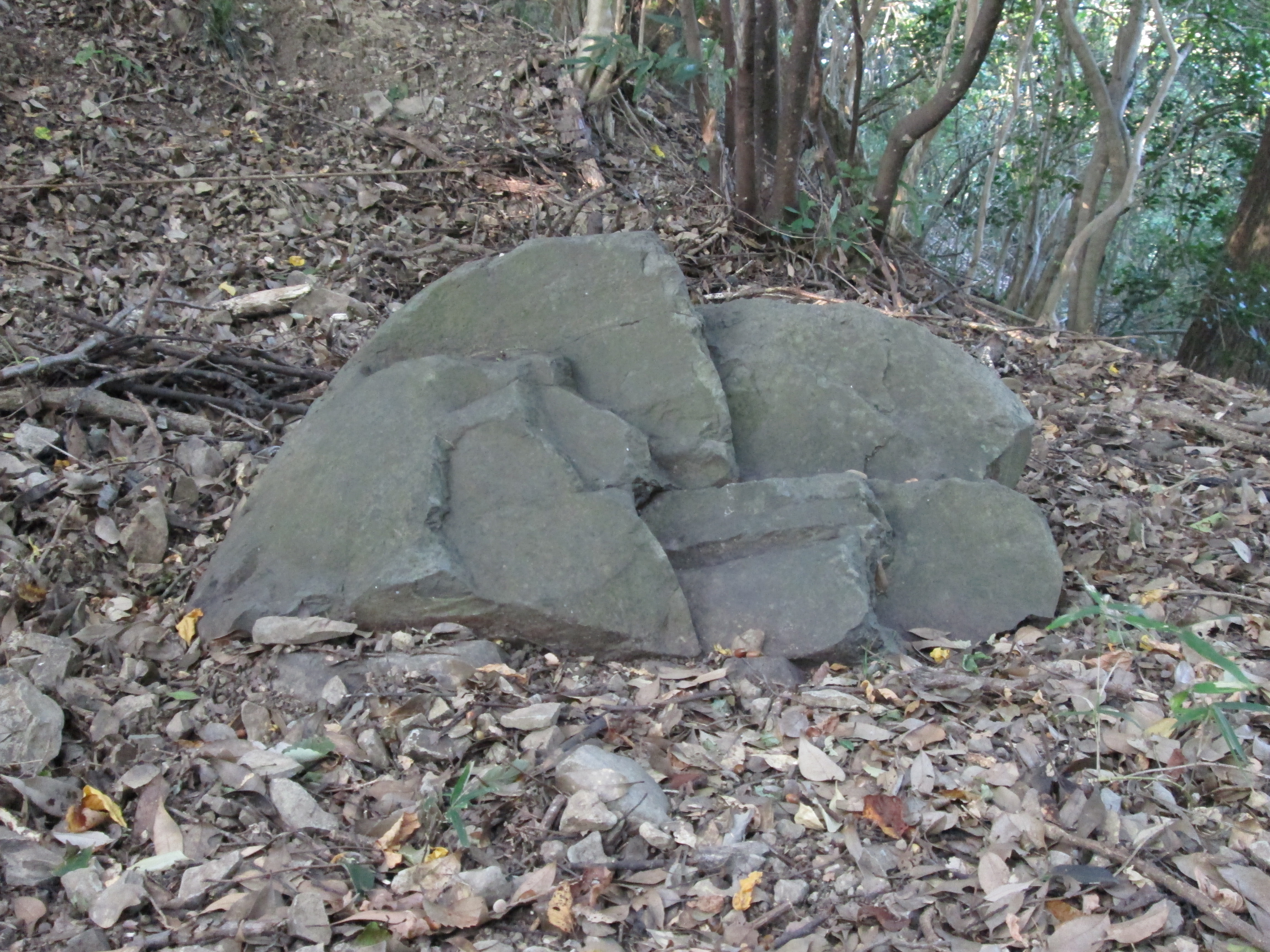
Yukimori's forces recaptured key castles on the Izumo-Hōki border, including Jūjin-yama Castle and Sueyoshi Castle, which were vital for maritime transport on Lake Nakaumi. They temporarily captured Seisuiji Castle, once again threatening Gassantoda Castle. To coordinate with Yonehara Tsunehiro, who was holding Takase Castle, they also seized and fortified Mangaji Castle on the northern shore of Lake Shinji. They pressed their attack on Kikkawa Motoharu, even advancing on his home castle, Tezakiyama Castle (Hirata Castle). Furthermore, they successfully gained the allegiance of Oki Danjōzaemon-no-jō of Oki Province, thereby securing naval control over the Sea of Japan coast. The Amago restoration army once again expanded its influence across the entire Shimane Peninsula.
On November 3, 1570, Motonari, upon receiving news of the Mori army's disadvantage in Izumo, dispatched his direct naval forces under Kodama Narihide to reinforce the Mori army and regain control of the Sea of Japan. With these reinforcements, the Mori army gradually gained the upper hand. By late October, Jūjin-yama Castle fell, followed by Mangaji Castle in December. The Amago restoration army's territory steadily shrank. Takase Castle fell on March 19, 1571, and Iwakura Castle in Hōki fell on May 14, 1571.
By September 8, 1571, Shinzan Castle, their last stronghold, fell. Amago Katsuhisa, who had been besieged there, managed to escape to Oki Province before the castle's fall. Around the same time, Yukimori, who had been fighting at Sueyoshi Castle, was defeated and captured by Kikkawa Motoharu. Yukimori was then imprisoned at Odaka Castle. However, thanks to the intercession of Shishido Takaie and Kuchiwa Michiyoshi, he was promised a stipend of 1,000 kan of land each in Tokuji, Suō Province, and Ōyama, Hōki Province. Yukimori refused this offer and, seizing an opportunity, managed to escape. This marked the end of the first Amago restoration movement in the San'in region.
5.2. Second Restoration Attempt
After escaping from Odaka Castle, Yamanaka Yukimori fled across the sea to Oki Province. By February or March 1572, he returned to the mainland and went into hiding in Tajima Province. During this period, he maintained contact with anti-Mori forces, including the pirate Murakami Takeyoshi in the Seto Inland Sea and Maki Naoharu, a senior retainer of the Mimasaka Miura clan, while awaiting another opportunity to restore the Amago clan. It is believed that during this time, Yukimori adopted the surname Kamei.
In early 1573, Yukimori invaded Inaba Province from Tajima, capturing Kiriyama Castle and establishing it as his base. From there, he began various military operations, likely planning to expand his influence into Hōki and Izumo. At this time, the de facto ruler of Inaba Province was Takeda Takanobu, a Mori-aligned local lord who had gained power in 1563 after defeating Yamana Toyokazu, the then-lord of Inaba.
Yukimori and the Amago restoration army allied with Yamana Toyokuni, Toyokazu's younger brother, who sought to revive the Yamana clan. They fought and won battles across Inaba Province, expanding their territory. On August 28, 1573, they achieved a decisive victory over the Takeda army in the Battle of Koshikiyama Castle, also known as Tottori no Tanomo Kuzure. Following this victory, they intensified their siege of Takanobu's stronghold, Tottori Castle.
The Amago restoration army, with approximately 1,000 soldiers, attacked Tottori Castle, defended by 5,000 Takeda troops. They continued their offensive and captured Tottori Castle in late September. The Takeda retainers within the castle surrendered, offering hostages to the Amago restoration forces. Yamana Toyokuni entered Tottori Castle, while the Amago restoration army established its headquarters at Shibue Castle. Yukimori subsequently captured 15 more castles within ten days, expanding his forces to over 3,000 and successfully bringing eastern Inaba Province under his control.
However, in early November, Yamana Toyokuni defected to the Mori side due to the machinations of figures like Tagimi Takatsugu. The Amago restoration army lost Tottori Castle to the Mori within little more than a month. With his forces destabilized by the loss of Tottori Castle, Yukimori continued to engage in various military activities and stratagems across Inaba to pacify the province.
While fighting the Mori forces in Inaba, Yukimori also sought alliances with anti-Mori powers such as the Mimasaka Miura clan, the Uragami clan of Bizen Province, and the Ōtomo clan of Buzen Province. He also secretly communicated with Shibata Katsuie, a retainer of Oda Nobunaga, to reorganize his forces. In November 1574, Yukimori repelled the forces of Ukita Naoie at Takata Castle, the stronghold of the Mimasaka Miura clan, earning him a pot of saltpeter, a gunpowder ingredient, from Ōtomo Sōrin in recognition of his achievements.
In July 1575, Yamana Suketoyo of Tajima Province concluded a peace agreement with the Mori clan, known as the "Geitan Peace." Although Suketoyo had previously supported the Amago restoration army against the Mori, his domain and the Ikuno Silver Mine were now threatened by Nobunaga, making an alliance with the Mori crucial for him. With the loss of support from the Tajima Yamana clan, Yukimori captured Wakasa Onigajō Castle in Inaba Province between July 21 and 22, and relocated his base there. It is said that Kamei Korenori then occupied Shibue Castle. Wakasa Onigajō Castle was strategically located at a key junction of mountain routes from Inaba to Tajima and Harima, allowing Yukimori to avoid the hostile Yamana territory in Tajima and secure a route from Harima to Kyoto.
In June, Kikkawa Motoharu and Kobayakawa Takakage led a massive army of approximately 47,000 soldiers into Inaba Province, launching a full-scale assault on the Amago restoration army. The Mori forces systematically captured the Amago restoration army's castles. On October 2, they attacked Wakasa Onigajō Castle, where Yukimori was besieged. Although the Amago restoration army successfully repelled the Mori's attacks, Shibue Castle fell by early October, leaving Wakasa Onigajō Castle as their last stronghold in Inaba. However, due to the Amago restoration army's fierce resistance and rising tensions between the Oda and Mori clans in the San'yō region, the Mori army withdrew from Inaba on November 23, after constructing numerous subsidiary castles around Wakasa Onigajō Castle.
Despite this, the Amago restoration army became completely isolated in Inaba due to the destruction of the Mimura clan, the decline of the Uragami clan, and the surrender of the Mimasaka Miura clan to the Mori. Furthermore, continuous pressure from the Mori forces in Inaba, even after the withdrawal of Motoharu's main army, forced the Amago restoration army to abandon Wakasa Onigajō Castle and withdraw from Inaba Province around May 1576. This marked the failure of the second Amago restoration movement.
5.3. Third Restoration Attempt and Final Struggle
After withdrawing from Inaba Province, Yamanaka Yukimori sought refuge with Oda Nobunaga in Kyoto. Upon meeting Nobunaga, Yukimori was praised as a "fine man" and was gifted a swift horse named "Shijūri Kage." From this point, Yukimori aimed to restore the Amago clan under the banner of the Oda army.
In 1576, Yukimori and the Amago restoration forces joined Akechi Mitsuhide's army, participating in the sieges of Yagi Castle in Tajima and Momii Castle in Tanba Province. In November, when Mitsuhide's army was defeated in the siege of Momii Castle, Yukimori and his forces served as the rear guard, repelling the pursuing Hatano and Akai forces and preventing the army's collapse, for which Mitsuhide rewarded them. He performed two other exceptional feats during the Tanba campaign.
In 1577, Yukimori followed Nobunaga's heir, Oda Nobutada, participating in the siege of Kataoka Castle and the siege of Shigisan Castle, where Matsunaga Hisahide was besieged. Yukimori was the first to enter Kataoka Castle and the second to enter Shigisan Castle. During these campaigns, Yukimori also defeated Kawai Shōkan, a general under Hisahide, in a one-on-one duel.
In October, Hashiba Hideyoshi (later Toyotomi Hideyoshi), acting on Nobunaga's orders, began his advance into Harima Province. Yukimori and the Amago restoration forces then left Mitsuhide's army to fight under Hideyoshi. In January 1578, Hideyoshi captured Kōzuki Castle, a Mori stronghold in western Harima. Yukimori and his lord, Amago Katsuhisa, entered the castle. The Amago restoration forces used Kōzuki Castle as their base for their final attempt to restore the Amago clan. Katsuhisa even issued a land grant to Kumano Taisha Shrine in Izumo, indicating his intention to return to Izumo.
Kōzuki Castle was a small fortress but strategically important for controlling the border regions of Bizen, Mimasaka, and Harima. As the castellan, Yukimori oversaw the castle's defense and engaged in diplomatic efforts to win over local lords in Mimasaka, such as mediating between the Oda clan and the Emishi clan of Mimasaka.
On March 9, 1578, Makabe Jirōshirō, a general of the Ukita clan, attacked Kōzuki Castle with approximately 3,000 soldiers. Yukimori, leading about 800 soldiers, launched a night raid on the Ukita forces, killing Jirōshirō and securing a victory for the Amago restoration army.
In late March, Bessho Nagaharu of Miki Castle rebelled against Nobunaga and allied with the Mori clan. The Mori clan, already at war with the Oda, saw this as an opportunity. In April, Kikkawa Motoharu and Kobayakawa Takakage led an army of over 30,000 soldiers into Harima Province. On May 24, they besieged Kōzuki Castle, where the Amago restoration forces were entrenched.
On June 9, Hideyoshi, upon learning of the Mori's siege of Kōzuki Castle, marched with Araki Murashige and an army of 10,000 soldiers to relieve the castle, taking up position on Mt. Takakura. However, Hideyoshi was ordered by Nobunaga to prioritize the attack on Miki Castle. Furthermore, Hideyoshi's forces were defeated by the Mori army in the Battle of Takakura-yama on July 25. Consequently, Hideyoshi withdrew his forces to Shoshazan on July 30, leaving Kōzuki Castle isolated. With provisions running out and desertions mounting, the Amago restoration forces surrendered to the Mori army on August 8 in the Siege of Kōzuki Castle.
As part of the surrender terms, Amago Katsuhisa and his younger brother, Sukeshirō, were forced to commit seppuku. Yukimori and Tachihara Hisatsuna were captured and taken as hostages. Many others who had defied the Mori were executed, though some were pardoned and released.
6. Death
Yamanaka Yukimori, taken as a hostage after the surrender of Kōzuki Castle, was being escorted to Mōri Terumoto's camp at Bitchu Matsuyama Castle in Bichū Province. However, en route, at Ai no Watari (阿井の渡しJapanese) in Bichū Province (present-day Takahashi, Okayama Prefecture), he was assassinated by Fukuma Motoaki, a retainer of the Mori clan. The exact date of his death is conventionally given as August 20, 1578. He was 34 years or 39 years old at the time of his death, depending on the historical source.
Yukimori's death effectively marked the end of the Amago restoration movement. However, not all Amago retainers were eliminated. A contingent led by Kamei Korenori, a member of a branch family of the Amago clan, managed to escape the fall of Kōzuki Castle by following Hideyoshi. These surviving Amago retainers were subsequently reorganized into the Kamei clan's retinue, embarking on a path to become a modern daimyō family.
Under Hideyoshi's command, Kamei Korenori continued to fight, initially promised "half of Izumo Province" as a reward. However, this promise was annulled after Hideyoshi's "Chūgoku Ogaeshi" (Great Return from Chūgoku) and his peace agreement with the Mori clan following the Honno-ji Incident. Korenori later adopted the title of "Ryūkyū-no-kami" (Governor of Ryūkyū) and sought Hideyoshi's approval to conquer the Ryukyu Kingdom, but this was thwarted by the Shimazu clan's invasion of Ryukyu. Korenori also participated in the Korean campaigns. After Hideyoshi's death, he sided with the Eastern Army in the Battle of Sekigahara, participating in actions such as accepting Saimura Masahiro's defection, burning down the area around Tottori Castle, and besieging and opening Natsuka Masaie's castle at Minakuchi in Ōmi Province. The Kamei clan was integrated into the Tokugawa shogunate's han system, receiving Shikano in Inaba Province, adjacent to Izumo. They engaged in red seal ship trade, sending ships to Siam. Later, after the Senhime Incident, they were transferred to Tsuwano in Iwami Province, close to the Chōshū Mori clan, where they remained as the Tsuwano Domain with 43,000 koku until the end of the Bakumatsu period.
Yukimori's eldest son, Yamanaka Yukimoto (also known as Kōnoike Shinroku), is said to have abandoned his samurai status after his father's death. He started a sake brewing business in Kōnoike Village, Settsu Province (present-day Itami, Hyōgo Prefecture), amassed wealth, and later moved to Osaka, becoming the founder of the wealthy Kōnoike zaibatsu in the Edo period and beyond. However, some historians dispute the Kōnoike family's claim that Shinroku was Yukimori's son.
Yukimori's unwavering loyalty to his fallen lord and his continuous struggle deeply resonated with later generations, serving as fertile ground for embellishment in kōdan (storytelling) and novels. Particularly during the Edo period, he was portrayed as a loyal warrior, and the tragic hero "Yamanaka Shikanosuke" was created. This image became widely known and was adopted as a subject for national education after the Meiji Restoration, which emphasized Bushido. His prayer to the crescent moon for "seven difficulties and eight pains" was even included in textbooks.
7. Origin and Historical Debates
The early life of Yamanaka Yukimori, particularly his birth date and birthplace, remains largely unclear due to a scarcity of definitive historical records. Even military chronicles, which often provide details about such figures, present conflicting information regarding his origins.
7.1. Birth Date
Conventionally, Yukimori's birth date is cited as August 15, 1545 (September 20, 1545), as recorded in works like the `Taikōki` and `Goko Taiheiki`. The `Meishō Genkōroku` states that he died on July 2, 1578 (August 5, 1578), at the age of 34, which, when calculated backward, aligns with a birth year of 1545. However, the `Un'yō Gunki`, the oldest existing historical record concerning him, states that he died on July 13, 1578 (August 16, 1578), at the age of 39. This would place his birth year in 1540. The `Intoku Taiheiki` and `Chūgoku Heiran Ki` also state that he died at 39 in 1578. Therefore, some theories propose his birth year as 1540. The commonly accepted death date, August 20, 1578, is based on the `Yamanaka Keizu Sōan` and `Katayose Kafu`.
7.2. Birthplace
His birthplace is also uncertain. It is generally believed that he was born at the foot of Gassantoda Castle (present-day Hirose-cho, Yasugi, Shimane Prefecture), a location mentioned in the `Taikōki`, where the site of his residence still exists today. However, the `Un'yō Gunki` and `Goko Taiheiki` state that he was born at the foot of Waniuchi-dera Temple (present-day Bessho-cho, Izumo, Shimane Prefecture), where a site believed to be his residence is also preserved. Additionally, there is a theory that he was born at Mikami Castle in Shinano Province, and a museum dedicated to Yamanaka Shikanosuke Yukimori's birthplace exists in Minamiaiki Village, Nagano Prefecture.
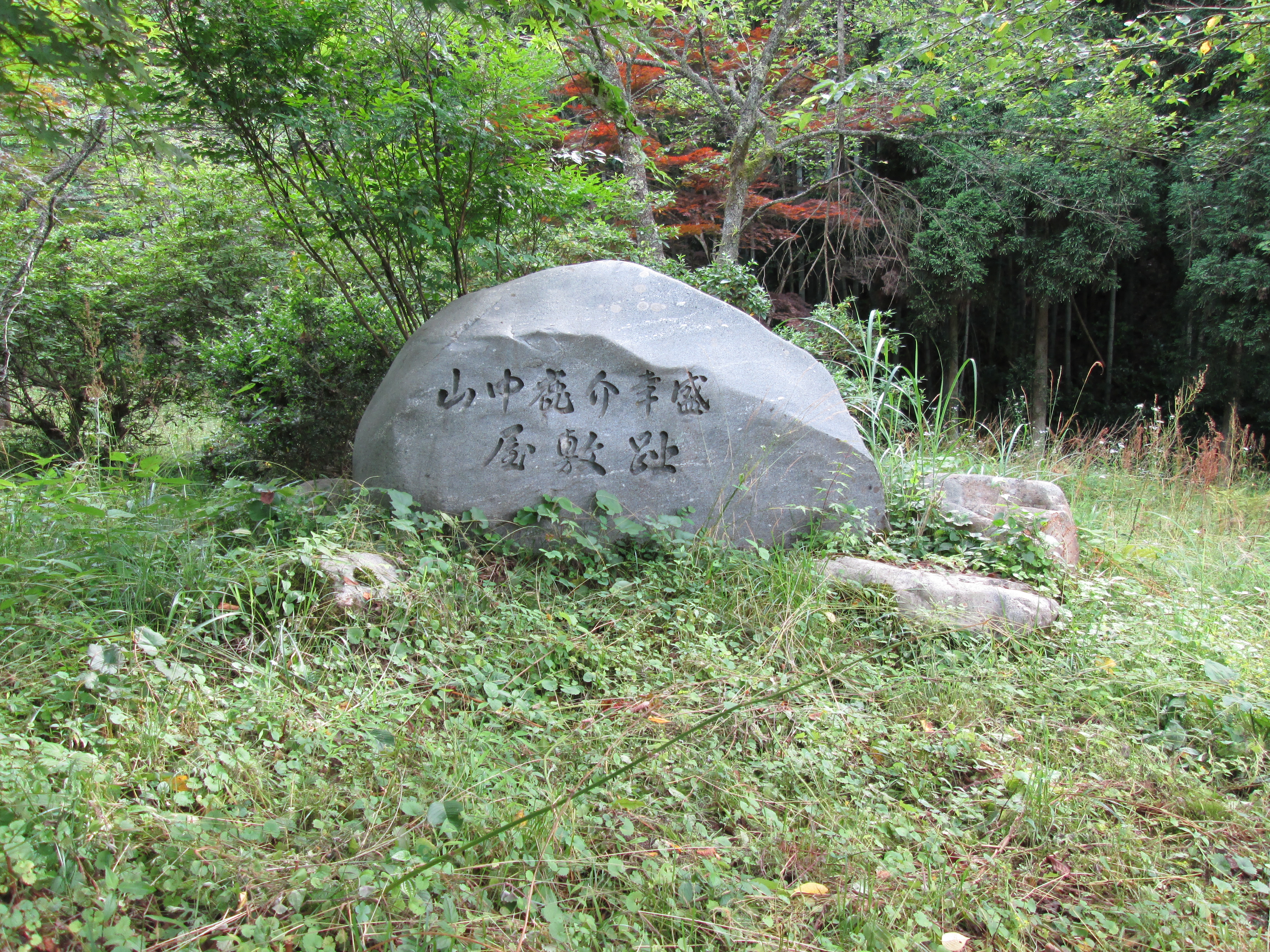
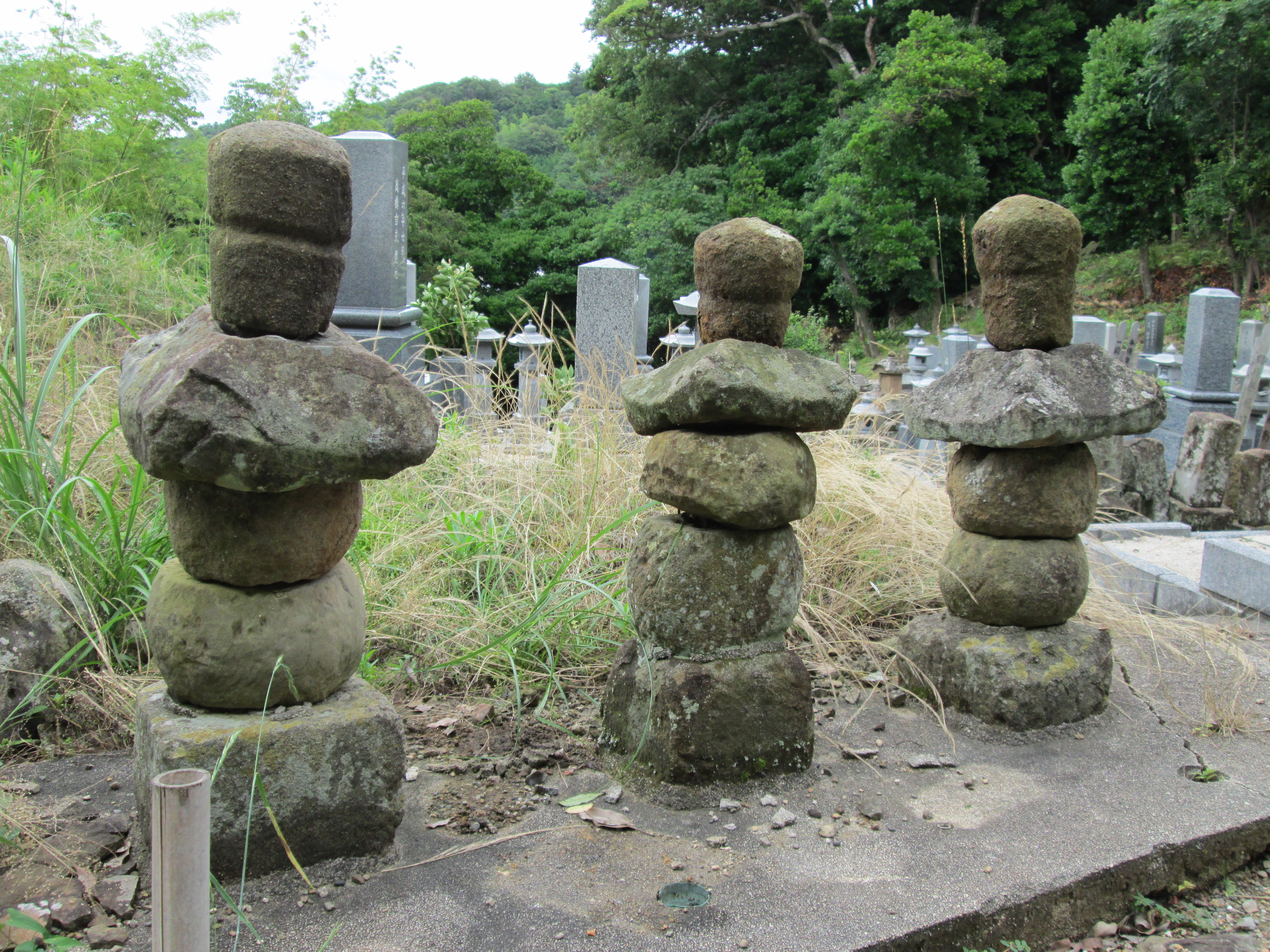
8. Evaluation and Legacy
Yamanaka Yukimori's character, military prowess, and unwavering loyalty have been highly praised by contemporaries and later historians, solidifying his enduring image as a tragic hero.
8.1. Historical Evaluation
Various historical figures and texts have offered assessments of Yamanaka Yukimori:
- Kikkawa Motonaga**: Described Yukimori as a "truly peerless warrior under heaven."
- Rai San'yō**: In his seven-character quatrain titled "Yamanaka Yukimori," he wrote: "His formidable fame, who would call him a deer? In a world of tigers and wolves, one sees a kirin (unicorn)." This verse is the origin of his nickname, "Kirinji of San'in."
- Katsu Kaishū**: Stated, "Looking back at the history of the past few hundred years, there are almost no individuals who, when faced with true adversity, handled matters calmly and composedly. If there are any, it would first be Yamanaka Shikanosuke and Ōishi Yoshio."
- Itagaki Taisuke**: Expressed his admiration, saying, "I always love Yamanaka Shikanosuke. He was a loyal retainer of the Amago, a man who devoted himself without reservation when the Amago's decline was irreversible." Itagaki further elaborated on Yukimori's famous prayer to the crescent moon, interpreting it as a symbol of his unwavering spirit in the face of adversity, comparing the waxing crescent to the fleeting full moon, and seeing in its imperfection a resonance with the samurai's spirit.
8.2. Symbolism
Yamanaka Yukimori's life and death have cemented his place in Japanese culture as a powerful symbol. He embodies unwavering loyalty (忠義Japanese, *chūgi*) to one's lord, perseverance (不屈Japanese, *fukutsu*) in the face of insurmountable odds, and tragic heroism (悲運の英雄Japanese, *hiun no eiyū*). His famous prayer to the crescent moon for "seven difficulties and eight pains" became a quintessential tale of self-sacrifice and dedication, particularly during the Meiji period and beyond, when it was incorporated into national education textbooks to promote the ideals of Bushido. He represents the ideal samurai who, despite personal suffering and repeated failures, never abandoned his ultimate goal, even if it meant his own demise. This image has made him a timeless figure of inspiration and a cornerstone of Japanese cultural identity.
8.3. In Popular Culture
Yamanaka Yukimori's dramatic life and unwavering loyalty have made him a popular subject in various forms of Japanese popular culture.
- In the `Samurai Warriors` video game franchise, Shikanosuke is a main playable character in `Samurai Warriors 5`. He is depicted as a loyal general of the Amago clan, known for his impressive courage and attractive appearance. In this game, he is voiced by Yōhei Azakami.
- He is also a playable character in `Sengoku Basara 4`, where he is portrayed as an accomplished martial artist and a loyal servant of Amago Haruhisa, who had previously appeared as a non-playable character in `Sengoku Basara 3`.
- Shikanosuke is the main protagonist of the Kabuki play "`Kō no Tori`" (神の鳥Japanese, "The Birds of the Gods"). In this play, he is depicted as a powerful `Aragoto` (rough style) hero, with a physical appearance strikingly similar to that of Kamakura Gongorō Kagemasa, the protagonist of `Shibaraku`. In `Kō no Tori`, Shikanosuke must save a family of Japanese storks (or Oriental storks) from the evil warlord Akamatsu Manyu, the play's main antagonist. The role of Shikanosuke is consistently played by the popular Kabuki actor Kataoka Ainosuke VI, who is considered one of the leading `tachiyaku` (male role) actors and a renowned `aragotoshi` (actor specializing in `aragoto` roles). The play has been performed at venues such as Kabuki-za in Tokyo and Eirakukan in Toyooka, Hyōgo, where it originated.
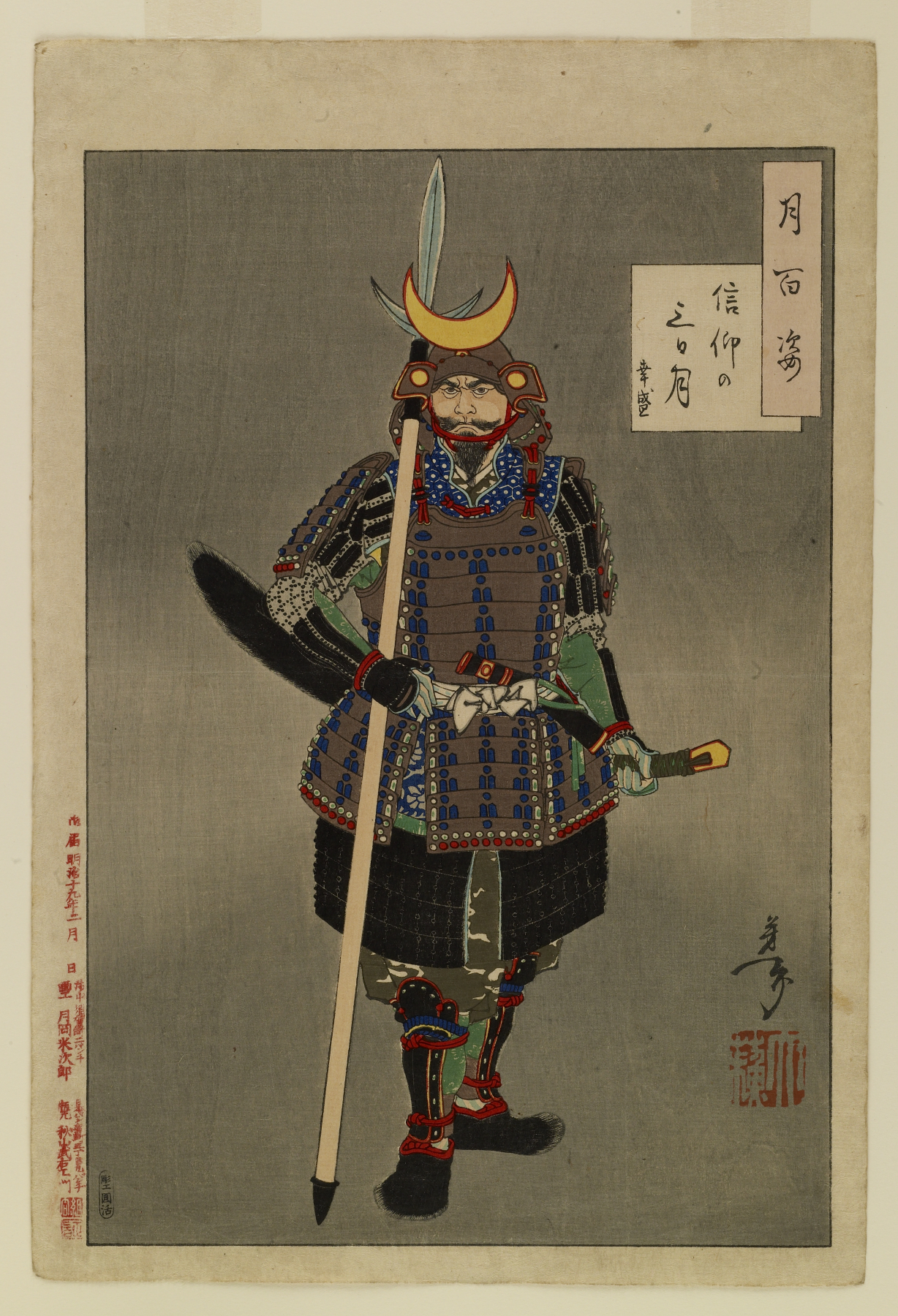
9. Personality and Anecdotes
Yamanaka Yukimori was not only a formidable warrior but also a man of remarkable character, known for his distinctive appearance, iconic armor, and deep-seated values instilled by his mother.
9.1. Appearance
Yukimori is often described as a fierce and handsome man, though historical accounts vary slightly on his specific features:
- The `Taikōki` describes his childhood appearance as unusual, with sharp eyes and strong, thick limbs. Even as a child, his demeanor was said to be remarkably resolute and even fearless.
- The `Un'yō Gunki`, describing him at 19 during his duel with Shinagawa Shoin, states he was about 59 in (150 cm) tall, of medium build, with fair skin and a refined appearance.
- The `Meishō Genkōroku`, describing him at the time of his death at 34, notes that Yukimori had a magnificent beard. This beard was said to be as sharp and stiff as a needle, capable of easily piercing a paper screen.
9.2. Armor and Helmet
Yukimori is famously depicted with a helmet featuring a crescent moon `maedate` (front ornament) and deer antler `wakidate` (side ornaments). This iconic image is common in storytelling and novels, and the bronze statue of Yukimori at the Gassantoda Castle ruins also portrays him in this armor. Conventionally, this helmet is believed to have been a family heirloom, passed down to Yukimori when he succeeded as head of the Yamanaka family. However, military chronicles like the `Taikōki` and `Un'yō Gunki` offer slightly different descriptions of his helmet:
- The `Taikōki` states that at the age of 16, he wore a helmet with a half-moon `maedate`, but does not mention deer antler `wakidate`. The front ornament is described as a half-moon, not a crescent moon.
- The `Un'yō Gunki` and `Intoku Taiheiki` describe him wearing red-laced armor and a helmet adorned with silver-powdered deer antlers, divided into five sections. While deer antler ornaments are mentioned, there is no mention of a crescent moon `maedate`.
- The `Meishō Genkōroku` mentions the "half-moon `maedate` helmet" from the `Taikōki` and adds that Yukimori inherited a helmet from his sickly elder brother. This helmet is described as having two deer antlers, each 5.9 ft (1.8 m) long, as its `maedate` (front ornament), not `wakidate` (side ornaments).
9.3. Bravery and Valor
Yamanaka Yukimori's martial skill and courage were legendary.
- He is considered the foremost among the "Amago Ten Braves" and one of the "Amago Three Greats," a trio of Amago generals particularly noted for their wisdom, bravery, and loyalty.
- He famously defeated Kikuchi Onehachi, Takano Kenmotsu, and Kawai Shōkan (a general under Matsunaga Hisahide) in one-on-one duels. His duel with Shinagawa Shoin is also well-known, though historical accounts vary. Amago-side records like the `Un'yō Gunki` and `Taikōki` depict Yukimori's clear victory after Shinagawa's bow attack was thwarted. Mori-side records like the `Intoku Taiheiki` suggest Shinagawa initially had the upper hand, and Yukimori only won with the assistance of his comrade, Akami Munenobu. The truth remains unclear, but the `Un'yō Gunki` and `Taikōki` are older sources.
- Yukimori performed "head memorial services" twice in his lifetime. A head memorial service was typically held after accumulating 33 enemy heads, meaning he took at least 66 heads in his career.
- It is said that Yukimori, only a few months old, appeared like a 4 or 5-year-old child. By the age of 2 or 3, he displayed exceptional bravery and cunning, and his games differed from those of ordinary children. He reportedly killed a person at eight, began studying mounted archery and military tactics at ten, and took an enemy head at thirteen. As he matured, his abilities surpassed others, his spirit was strong, his foresight deep, and he showed no favoritism in praising people.
- One spring day, at the age of 16, Yukimori prayed to the crescent moon, wishing to achieve military glory within 30 days. Soon after, his lord, Amago Yoshihisa, attacked Odaka Castle in Hōki Province, and Yukimori accompanied him. In this battle, Yukimori achieved renown by defeating Kikuchi Onehachi, a formidable warrior from Inaba and Hōki, in a one-on-one duel. From then on, Yukimori is said to have worshipped the crescent moon throughout his life.
- In 1562, when the Mori army invaded Izumo Province and besieged Gassantoda Castle, Yukimori was resting alone in a civilian house at the foot of the castle. About 30 to 40 Mori cavalrymen attacked. Yukimori emerged from the house, cut down the first two riders, and then engaged the remaining soldiers in a fierce melee, killing 16 or 17 of them. He single-handedly repelled the rest. Afterward, he asked an elderly nun in the house for food, ate rice served on a shiitake leaf, and returned to Gassantoda Castle.
- While wandering as a rōnin after the fall of the Amago clan, Yukimori stayed overnight at a temple. Fourteen thieves attacked the temple. Yukimori, using stratagem, single-handedly captured all of them. The thieves, astonished, asked for his name, stating they had committed about 100 thefts and fought over 70 battles but had never encountered such a feat. Yukimori, however, refused to reveal his name, telling them to leave, as he had decided to release them after consulting with the temple's chief priest, believing it improper to kill in the presence of divine beings.
9.4. Mother's Influence
Yamanaka Yukimori's mother, Nami, was renowned as an exceptionally wise and virtuous woman. As Yukimori's father died young, Nami raised him alone. Despite their poverty, she cultivated hemp to make clothes for Yukimori while wearing tattered garments herself. She also extended her kindness to other poor children, providing them with clothing, lodging, and food. These children, grateful for her care, later grew up to support Yukimori. Nami taught Yukimori to always share hardships and joys with his followers, never to abandon his comrades in defeat, and to avoid monopolizing credit for victories. Yukimori is said to have always remembered and followed these teachings.
9.5. Relationships and Conduct
Yukimori's character was further illuminated by his interactions with others:
- When Oki Tamekiyo and others rebelled at Mihonoseki (Battle of Mihonoseki), Yukimori's forces were in a dire situation after being counterattacked. When the Yokomichi brothers (Yokomichi Takamitsu, Yokomichi Takamune) and Matsuda Shigeho arrived as reinforcements and fought valiantly, leading to Tamekiyo's capture and victory, Amago Katsuhisa hesitated to issue letters of commendation to the Yokomichi brothers out of deference to Yukimori. However, Yukimori advised Katsuhisa, "If it were not for their assistance in this battle, I would have lost my life. Do not hesitate out of consideration for us, who were defeated in the initial engagement. Rewards and punishments must be clear; there should be no favoritism in governance." Katsuhisa, pleased by this counsel, immediately issued the commendations.
- Nonoguchi Tanba, a retainer of Akechi Mitsuhide, invited Yukimori to his humble home. Later, Mitsuhide also invited Yukimori to his residence for a bath. Yukimori politely declined Mitsuhide's invitation, stating with a smile, "I have a prior engagement with Nonoguchi." Mitsuhide, also smiling, then instructed Nonoguchi to "invite Yukimori with this," bestowing upon him a wild goose and a salmon.
- A letter from Yukimori to his subordinate, Shindo Kansuke, is preserved, believed to be his last letter written before his assassination at Ai no Watari. In it, Yukimori praises Kansuke's long years as a rōnin and his unparalleled bravery during the siege of Kōzuki Castle, stating he would "never forget it." He then released Kansuke from his service, advising him to seek employment wherever he wished.
- After the fall of Kōzuki Castle, when Hashiba Hideyoshi decided to retreat and abandon the castle, he reportedly exclaimed to Oda Nobutada, "How regrettable it is to abandon Yukimori! If Lord Nobunaga had personally led the relief effort for Kōzuki Castle, the Mori clan would have been destroyed, and the Chūgoku and Tsukushi regions would have been at Nobunaga's will. However, due to the slander of treacherous retainers, Yukimori was abandoned, and this ill reputation has spread to the ends of the western provinces. The intentions of treacherous retainers are the same now as they were in the past!"
- In July 1578, when Kōzuki Castle fell to the Mori army and Hideyoshi's relief forces withdrew, Yukimori pleaded repeatedly with Mori generals Kikkawa Motoharu and Kobayakawa Takakage for Amago Katsuhisa's life. However, they refused, threatening to kill everyone in the castle if Katsuhisa did not commit seppuku. With no other options, Yukimori tearfully told Katsuhisa, "I have repeatedly pleaded for your life, my lord, but Motoharu and Takakage refuse. At this point, our strength and fortune are exhausted, so please commit seppuku. While it is natural for me to follow you, I intend to feign surrender and, when close to the hateful Kikkawa Motoharu, stab him, thus avenging our clan's long-held resentment. It is regrettable to seem to cling to life and be seen as a disloyal defector, but I will quickly follow you across the Sanzu River and prove my unwavering loyalty then." Katsuhisa replied, "I was originally destined to live out my life as a monk in Kyoto. Yet, for a time, I was able to lead tens of thousands of soldiers as the Amago clan's general. Though brief, it was a good dream. What resentment could I possibly hold in committing suicide now? Moreover, if my death saves the lives of my subordinates, it is rather fortunate for a general. While it would be commendable to avenge me by stabbing Motoharu, he is a man of great wisdom and courage, so such an opportunity may not arise. Instead, live on, find another Amago branch family member, support them as a new lord, and strive for the Amago's restoration." With these words, Katsuhisa bid Yukimori farewell.
- After the fall of Kōzuki Castle, Yukimori was taken prisoner. Oka Chikuzen-no-kami Motoyoshi, a short and unattractive but exceptionally brave Mori retainer, came to visit him. Yukimori, meaning to compliment him, said with a smile, "Now that I meet you, Lord Chikuzen, your appearance is quite different from what I heard." Motoyoshi, taking this as an insult, retorted, "Indeed, people's appearances differ from what one hears. I heard Lord Yukimori was an unrivaled warrior in Japan, but I never imagined a samurai who would advise his lord to commit seppuku and surrender to the enemy. Truly, what one hears and what one sees are vastly different." Yukimori, receiving these words, could only remain silent, tears streaming down his face.
- Awa Hikogorō (Awata Narimitsu), a Mori retainer, asked Mōri Terumoto why his fellow retainer, Kuchiwa Michiyoshi, was so distressed. Terumoto replied that Michiyoshi was shocked because he had not been informed beforehand about Yukimori's assassination, and advised to leave him be.
- It is said that after his homeland was destroyed by the Mori clan in his youth, Yukimori led a band of about 300 strong warriors, serving as mercenaries who fought for various lords across the Chūgoku and Kinai regions. Upon hearing of this, Kobayakawa Takakage argued to Mōri Terumoto that Yukimori, despite his unmatched military strategy and courage, was a "two-faced samurai" who could be an enemy one day and an ally the next, thus betraying the true spirit of a warrior. Takakage advocated for his assassination, leading to assassins being sent to kill Yukimori.
- When Yukimori was assassinated by the Mori assassin Watanuki Samanosuke (Uzuki Ichinichi Samanosuke), he had two young pages with him. These pages buried Yukimori's body by the riverbank, erecting a mound. As it was early March, they broke off branches of peach blossoms and stuck them into the mound, saying, "Although Yamanaka Shikanosuke was assassinated, he was an honorable samurai. If Heaven has mercy, may these flowers take root." They then recited Buddhist prayers and committed seppuku. Samanosuke buried the two pages' bodies alongside Yukimori's mound. Afterward, the peach branches took root and grew into a large tree. However, a rumor spread that drinking water from this tree would cure malaria, leading people from both within and outside the country to chip away at the tree, eventually causing it to wither and die.
9.6. The Name "Shikanosuke"
There are several anecdotes regarding the origin of Yukimori's popular given name, "Shikanosuke" (鹿介Japanese). His childhood name was Jinjirō. He adopted the name Shikanosuke when he succeeded as head of the family, replacing his sickly elder brother.
- The most common theory suggests that he adopted the name "Shikanosuke" (meaning "deer's assistant" or "deer boy") in reference to the crescent moon `maedate` and deer antler `wakidate` on the helmet he inherited.
- Another theory states that he was named Shikanosuke because he ran around the mountains like a deer.
- The `Taikōki` offers a different account: One night in September, Jinjirō (Yukimori) was on night watch with his comrades, Akiyake Jinsuke and Teramoto Hanshirō. Bored, Jinjirō suggested they change their names based on their surnames. His friends agreed, and thus, Jinjirō became Yamanaka Shikanosuke, Akiyake became Akiyake An'nosuke, and Teramoto became Teramoto Shōjinosuke.
- The `Gizan Kōkaku` presents a more dramatic origin: Yukimori was born as the youngest son of Amago Haruhisa. When he was two years old, the Amago clan was destroyed by Mōri Motonari, and he was carried by his wet nurse to a place called "Yamanaka" (meaning "in the mountains") to hide. He grew up there until he was 16 or 17, possessing excellent character and physique, with tufts of hair on his joints. Because of this, he named himself Yamanaka Shikanosuke.
- The `Meishō Genkōroku` states that Jinjirō (Yukimori) once received a helmet from his elder brother, Jinjirō, which had two deer antlers, each 5.9 ft (1.8 m) long, as its `maedate`. When Jinjirō wore this helmet into battle, people were immediately awed and intimidated by his majestic appearance. Because of this, Yukimori began to call himself Shikanosuke.
9.7. Notable Possessions
Several famous weapons and artifacts are associated with Yamanaka Yukimori, contributing to his legend:
- He is said to have used a large Sekishū `ōdachi` (great sword), approximately 104 in (264 cm) in total length (blade length 68 in (172 cm), curvature 1.2 in (3 cm), tang length 36 in (92 cm)), crafted by Sekishū Kazusada. This `ōdachi` was reportedly dedicated to Ōyamazumi Shrine and is still displayed there for public viewing.
- A `kabuto` (helmet) known as the "Tetsusabi Jūniken Sujikabuto" (Iron-Rust Twelve-Plate Ridged Helmet), believed to have been in his possession when he surrendered to Kikkawa Motoharu after the fall of Kōzuki Castle, still exists. It is said that he kept a charm inside the helmet. This helmet is currently displayed at the Kikkawa Historical Museum.
- He owned the `ōdachi` "Arami Kuniyuki no Tachi," a sword made by Rai Kuniyuki, a swordsmith from Kyoto during the mid-Kamakura period. He carried this sword when he was assassinated at Ai no Watari. Afterward, it came into the possession of Mōri Terumoto. It is said that Terumoto later presented it to Toyotomi Hideyoshi.
- According to the `Kyōhō Meibutsu Chō`, he temporarily possessed "Mikazuki Munechika," one of the Five Swords Under Heaven.
- He also possessed the `ōdachi` "Fudō Kuniyuki no Tachi."
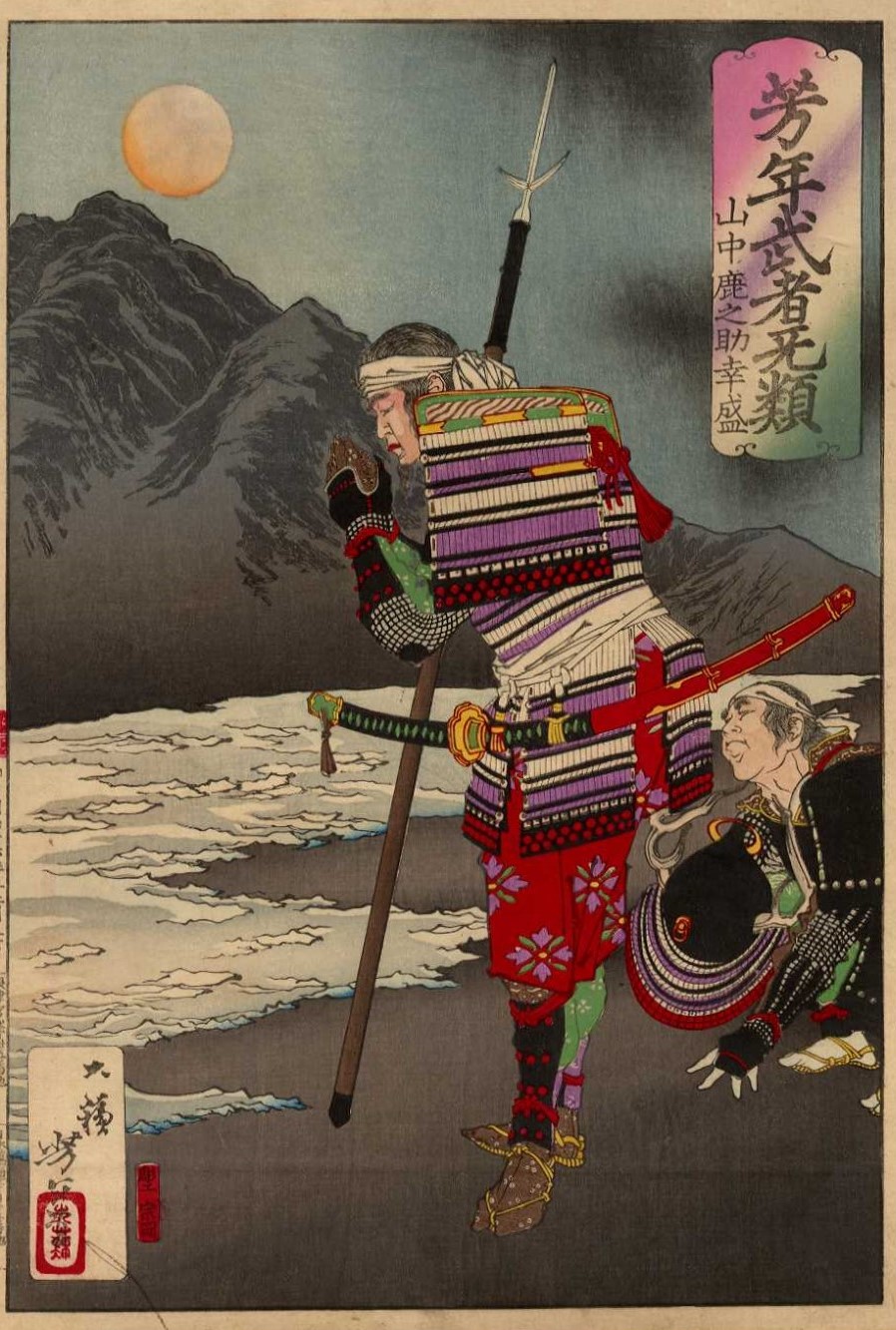
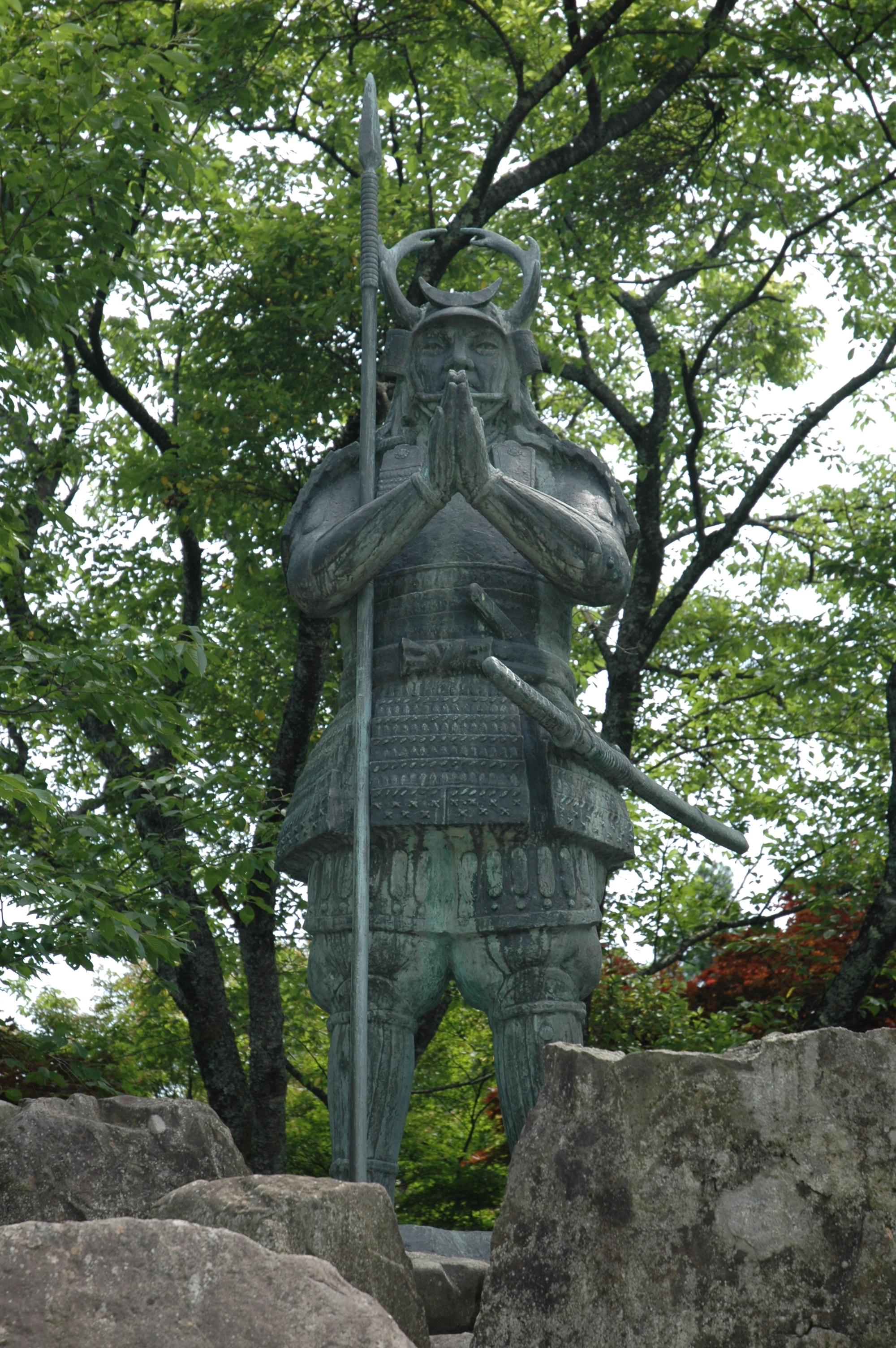
Yamanaka Yukimori's kaō (stylized signature) from a letter to Endō Kansuke dated July 8, 1578.

10. Genealogy
Yamanaka Yukimori's family lineage is as follows:
- Father**: Yamanaka Mitsuyuki (Mikawamori)
- Mother**: Nami (浪), daughter of Tachihara Tsunashige
- Grandfather**: Yamanaka Sadayuki
- Paternal Uncle**: Tachihara Hisatsuna
- Paternal Uncle**: Yamanaka Nobunao
- Legal Wife**: Chigira (高松院), eldest daughter of Kamei Hidetsuna
- Eldest Son**: Yamanaka Yukimoto (Kōnoike Shinroku)
- Second Son**: Yamanaka Yukinori
- Adopted Daughter**: Tokiko (栄壽院, 英樹院), who married Kamei Korenori. She was the second daughter of Kamei Hidetsuna.
- Second Daughter**: Yaehime (盛江), who married Yoshiwa Yoshikane.
- Descendants**:
- Kōnoike Zen'emon (founder of the Kōnoike zaibatsu)
- Yamanaka Toyoko
- Lapis Lazuli (singer) (contemporary singer with British grandfather)
11. Works Based on Yamanaka Yukimori
Yamanaka Yukimori's life and legend have inspired numerous works across various media:
- Novels**
- Picture Books**
- Manga**
- Television Dramas**
- Stage Plays**
12. Related Figures and Events
Yamanaka Yukimori's life was intertwined with many key figures and events of the Sengoku period:
- Clans**:
- Uda Genji: The ancestral clan of the Yamanaka.
- Sasaki clan: A branch of the Uda Genji, from which the Yamanaka clan originated.
- Kyōgoku clan: The main branch of the Sasaki clan.
- Amago clan: Yukimori's primary lord and the clan he served with unwavering loyalty.
- Mōri clan: The primary adversaries of the Amago clan, who ultimately brought about their downfall.
- Oda clan: The powerful clan led by Oda Nobunaga, whom Yukimori sought aid from in his later restoration efforts.
- Yamana clan: A clan that initially supported the Amago restoration movement against the Mori.
- Ukita clan: A clan in Bizen Province that clashed with Yukimori's forces.
- Bessho clan: A clan that rebelled against the Oda and allied with the Mori, impacting Yukimori's final campaign.
- Kamei clan: A branch family of the Amago, into which Yukimori was briefly adopted, and whose descendants continued the Amago legacy.
- Kōnoike zaibatsu: A prominent business conglomerate founded by descendants believed to be Yukimori's son.
- Individuals**:
- Amago Yoshihisa: Yukimori's lord, the last head of the Amago clan before its temporary fall.
- Amago Katsuhisa: The adopted leader of the Amago restoration movement, whom Yukimori served.
- Mōri Motonari: The formidable head of the Mori clan, who led the conquest of the Amago.
- Kikkawa Motoharu: A prominent Mori general and son of Motonari, a frequent adversary of Yukimori.
- Kobayakawa Takakage: Another prominent Mori general and son of Motonari, also a key adversary.
- Oda Nobunaga: The powerful unifier of Japan, whom Yukimori sought assistance from.
- Akechi Mitsuhide: An Oda general under whom Yukimori served for a period.
- Toyotomi Hideyoshi: An Oda general who later became a unifier, under whom Yukimori fought in his final campaign.
- Matsunaga Hisahide: A daimyō and a target of Oda's campaigns, in which Yukimori participated.
- Tachihara Hisatsuna: A loyal Amago retainer and ally of Yukimori in the restoration movement.
- Kamei Korenori: A member of the Amago branch family who continued the Amago legacy after Yukimori's death.
- Fukuma Motoaki: The Mori retainer who assassinated Yukimori.
- Nami: Yukimori's wise and influential mother.
- Kikuchi Onehachi, Takano Kenmotsu, Shinagawa Shoin, Kawai Shōkan: Warriors defeated by Yukimori in duels.
- Yamana Suketoyo: A daimyō who supported the first Amago restoration attempt.
- Yamana Toyokuni: A member of the Yamana clan who allied with Yukimori in the second restoration attempt.
- Takeda Takanobu: A Mori-aligned lord in Inaba, whose castle was targeted by Yukimori.
- Ōtomo Sōrin: A daimyō who provided support to Yukimori.
- Murakami Takeyoshi: A pirate leader who assisted Yukimori in his movements.
- Maki Naoharu: A retainer of the Mimasaka Miura clan, allied with Yukimori.
- Jinzai Motomichi: A former Amago retainer who later rejoined Yukimori's cause.
- Oka Chikuzen-no-kami Motoyoshi: A Mori retainer who had a notable exchange with Yukimori.
- Kuchiwa Michiyoshi: A Mori retainer who interceded for Yukimori and was distressed by his death.
- Events**:
- Siege of Shiraga Castle (1563)
- Battle of Yumigahama (1564)
- Second Siege of Gassantoda Castle (1565-1567)
- Ōuchi Teruhiro's Rebellion (1569)
- Battle of Fubeyama (1570)
- Battle of Koshikiyama Castle (Tottori no Tanomo Kuzure) (1573)
- Siege of Tottori Castle (1573)
- Siege of Shigisan Castle (1577)
- Siege of Kōzuki Castle (1578)
13. Grave Sites
Yamanaka Yukimori has several grave sites and memorial towers across Japan, reflecting his widespread veneration and the historical movements of his family and followers.
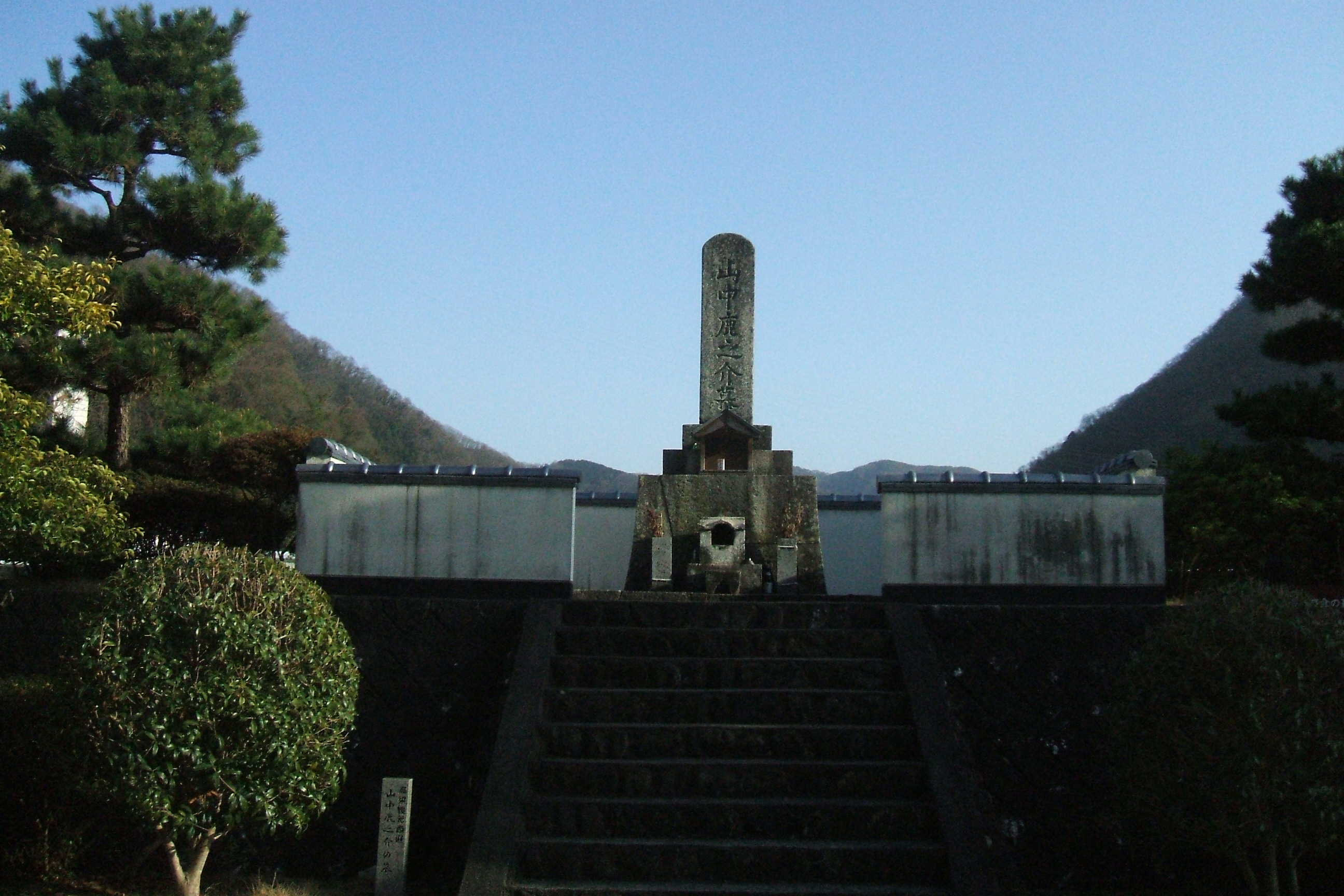
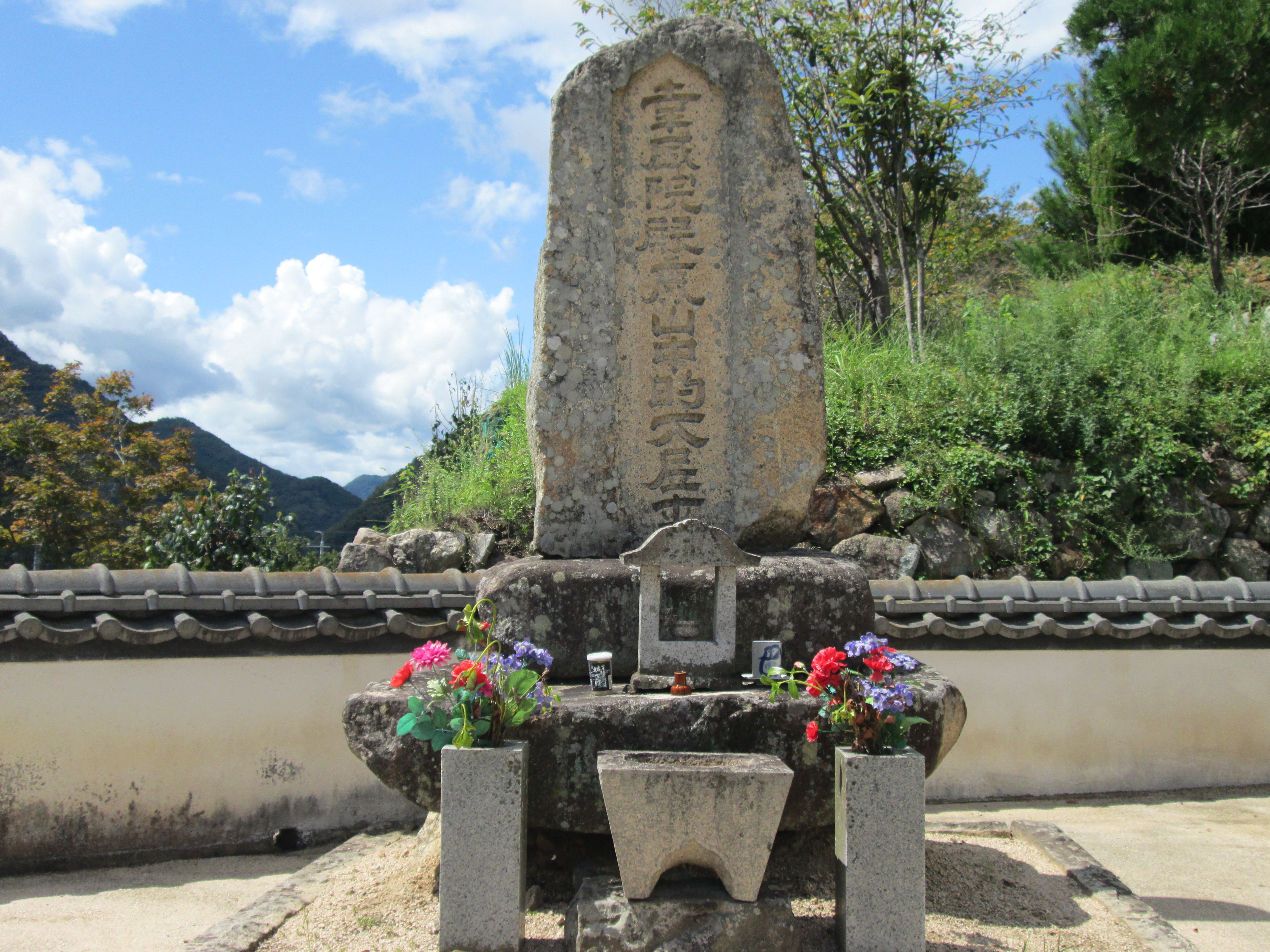
- Ai no Watari Grave (Ochiai-cho Abe, Takahashi, Okayama Prefecture)**: Yukimori was assassinated at Ai no Watari while being transported to Mori Terumoto's camp. In October 1713, Maeda Ichinoshin Tokimune and Sasaki Gunroku, samurai of the Matsuyama Domain, erected a tombstone here out of pity for his death. The inscription reads: "Amago Ten Braves, peerless among peers, unable to fulfill his aspirations, encountered no opportune moment. Loyal heart, righteous liver, here established, here sealed. Distinguished service, great achievements, fragrant for a thousand years."
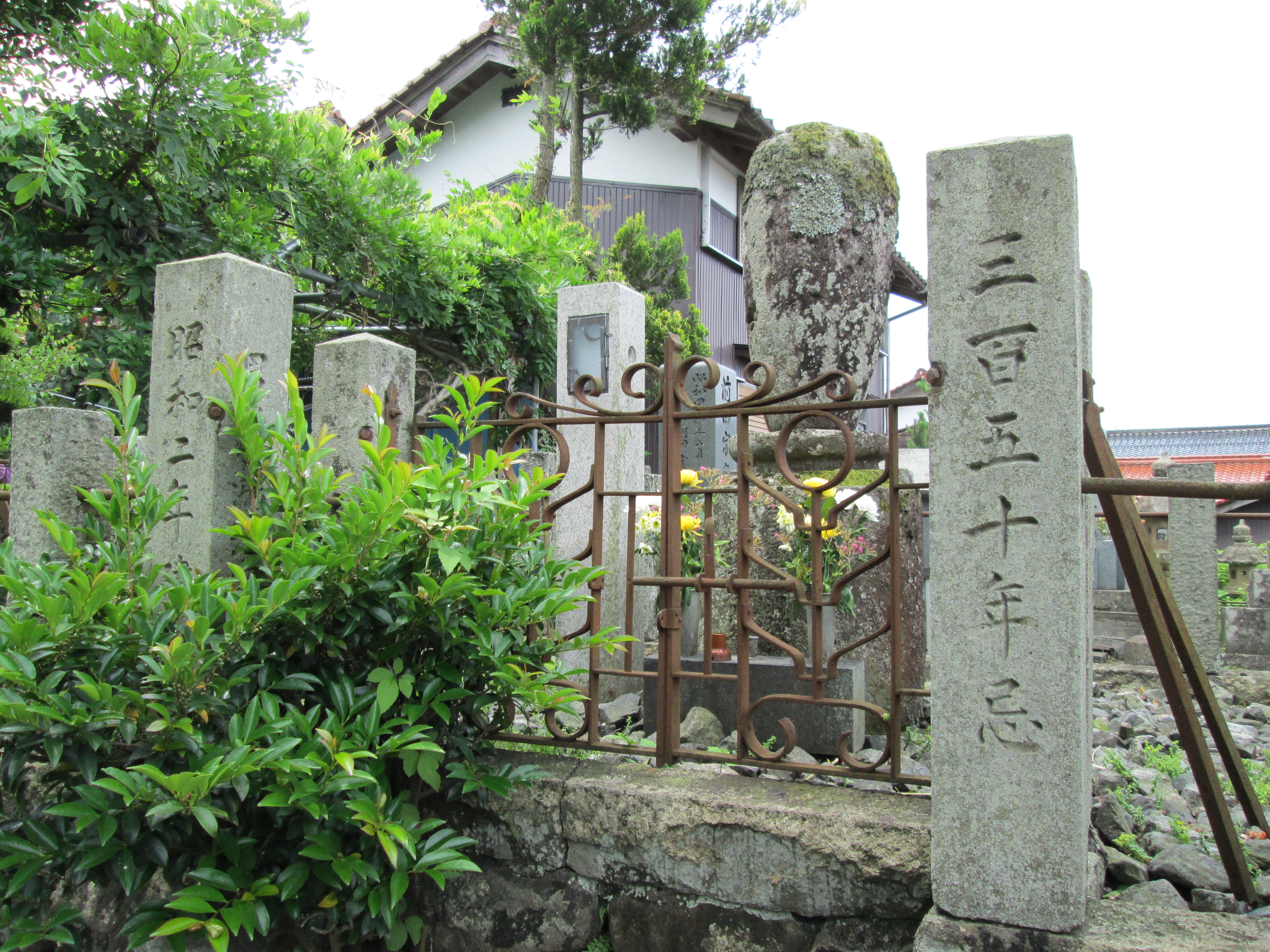
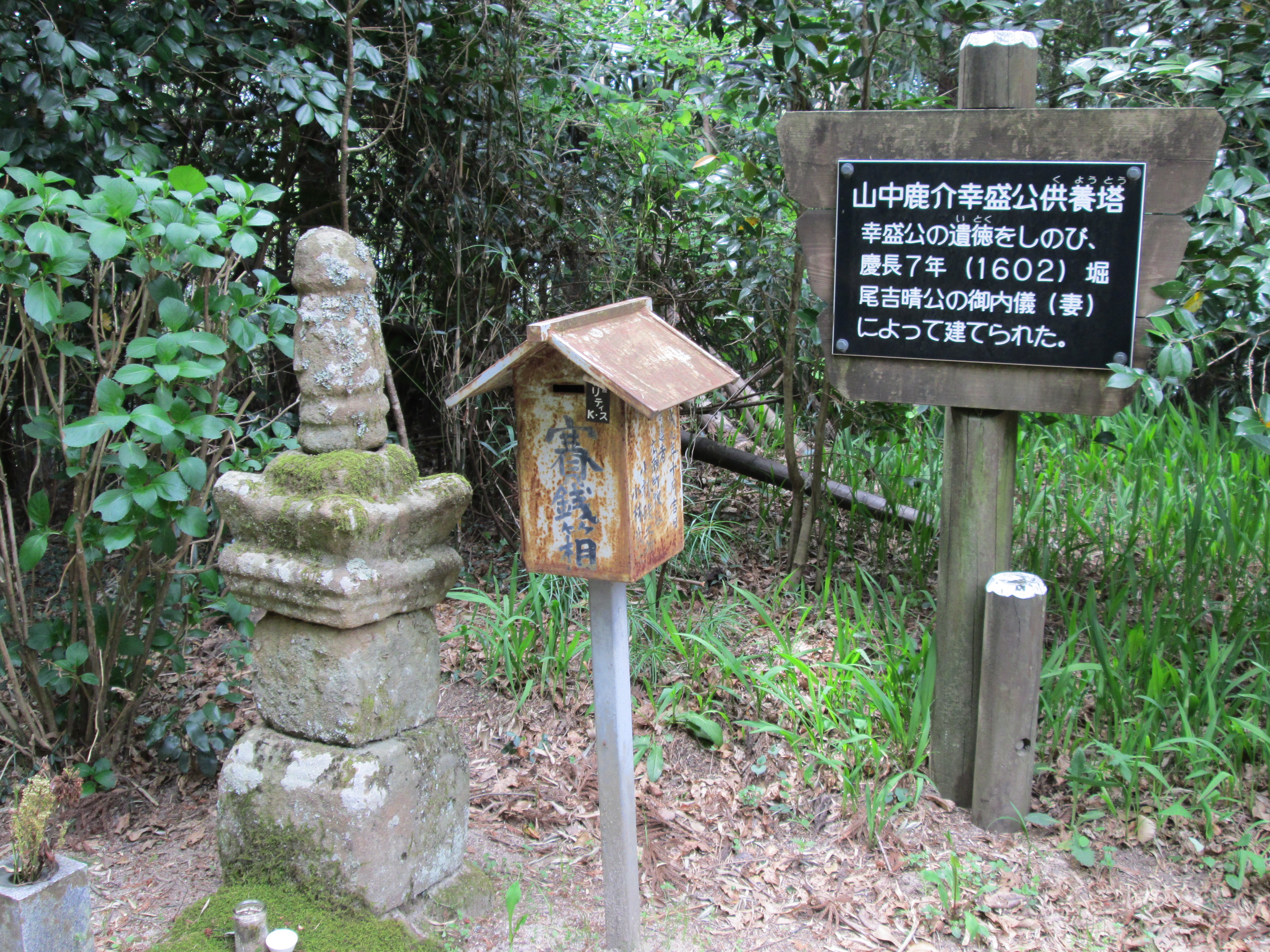
- Kansenji Temple Grave (Ochiai-cho Abe, Takahashi, Okayama Prefecture)**: It is said that the chief priest of Kansenji Temple, San'gyū Oshō, a Sōtō Zen Buddhist temple, took Yukimori's body and buried it in Sekikindō (Seikōdō). Yukimori's mortuary tablet is also enshrined within the temple. His posthumous Buddhist name is "Kōshōin Kazanyūteki Koji." In 1902, the 14th generation chief priest, Kinchi Soei, erected a new tombstone, and Yukimori was posthumously granted the name "Kōshōin-dono Kazanyūteki Daikoji."
- Gyokurin-in, Daitoku-ji Temple Grave (Murasakino Daitokuji-cho, Kita-ku, Kyoto)**: This grave was erected on May 22, 1743, by 18 members of the Kōnoike family, merchants from Osaka and descendants of Yukimori. The Kōnoike family established a memorial hall called "Nanmei-an" within Gyokurin-in during the mid-Edo period to pray for their ancestors, where Yukimori's mortuary tablet is also enshrined. His grave is located in the cemetery opposite Nanmei-an. The inscription on the back of the tombstone, written in classical Chinese, states that Yamanaka Yukimori, a loyal retainer of the Amago, was brave from childhood and a vanguard in battle. He died in battle at Abe, Bichū, at the age of 34, on May 22, 1578. His descendants, the 18 members of the Kōnoike family, conspired to erect this stone in Gyokurin Zen'in of Murasakino, first to repay their origins and to display it for eternity.
- Jissen-in, Honman-ji Temple Grave (Teramachi, Kamigyō-ku, Kyoto)**: This grave was erected on May 22, 1764, by Yamanaka Eitatsu and Yamanaka Isshin, who were also descendants of Yukimori. Yukimori's grave is located in the center of the cemetery next to the main hall, surrounded by the gravestones of the Yamanaka family. The inscription on the back, also in classical Chinese, is similar to the Daitoku-ji inscription, stating that Yamanaka Yukimori, a loyal retainer of the Amago, died in battle at Abe, Bichū, at the age of 30 (or 34) on May 22, 1578. His descendants, Yamanaka Eitatsu and Yamanaka Isshin, conspired to widely proclaim and dedicate this stone to Hōsen-ji Honman-ji Temple, first to repay their origins and to display it for eternity.
- Konkō-in, Konkai Kōmyō-ji Temple Grave (Kurodani-cho, Sakyō-ku, Kyoto)**: A `gorintō` (five-ringed pagoda) for Yukimori is erected at the entrance of the stone steps leading to Monjudō, in the center of the cemetery behind Konkō-in. Two other `gorintō` for Kamei Korenori and his wife (Yukimori's adopted daughter) are nearby. The inscription on Yukimori's `gorintō` reads: "Yamanaka Shikanosuke of Unshū, Junrin-in-dono Taiyo Jōryō Daizenjōmon, July 17, 1578."
- Kōshōji Temple Grave (Shikano-cho Shikano, Tottori, Tottori Prefecture)**: Originally named Meishōzan Jisaidera, this temple was founded between 1449 and 1452 by Gyōa Shōnin. In 1592, Kamei Korenori, the lord of Shikano Castle, ordered the chief priest of Meishōzan Jisaidera, Shōyo, to relocate the temple to its current site and rename it Kōshōji Temple (鹿野山幸盛寺) to pray for Yukimori's repose. In 1608, Korenori collected several fragments of Yukimori's remains from the site of his death in Bichū and constructed a grave within the temple grounds. The inscription reads: "July 2, 1583, for Kōshōji-dono Junrin Jōryō Koji, erected by Shamon Renge Shōyo Shōnin." Yukimori's mortuary tablet is also enshrined here, with the posthumous name "Kōshōji-dono Junrin Jōryō Koji."
- Gankuraji Temple Memorial Tower (Tomita, Hirose-cho, Yasugi, Shimane Prefecture)**: This memorial tower was erected in July 1602 by the wife of Horio Yoshiharu in praise of Yukimori's loyalty. During World War II, it was temporarily moved to a corner of the family cemetery within the temple grounds due to agricultural expansion. Yukimori's mortuary tablet is also enshrined within the temple. The inscription on the back of the tablet reads: "July 17, 1578, died in battle against the Mori clan at Abe no Watari in Bichū. Erected by the 22nd generation chief priest, Kan'yo, in February 1643." His posthumous name is "Kōshōji-dono Junrin Jōryō Koji."
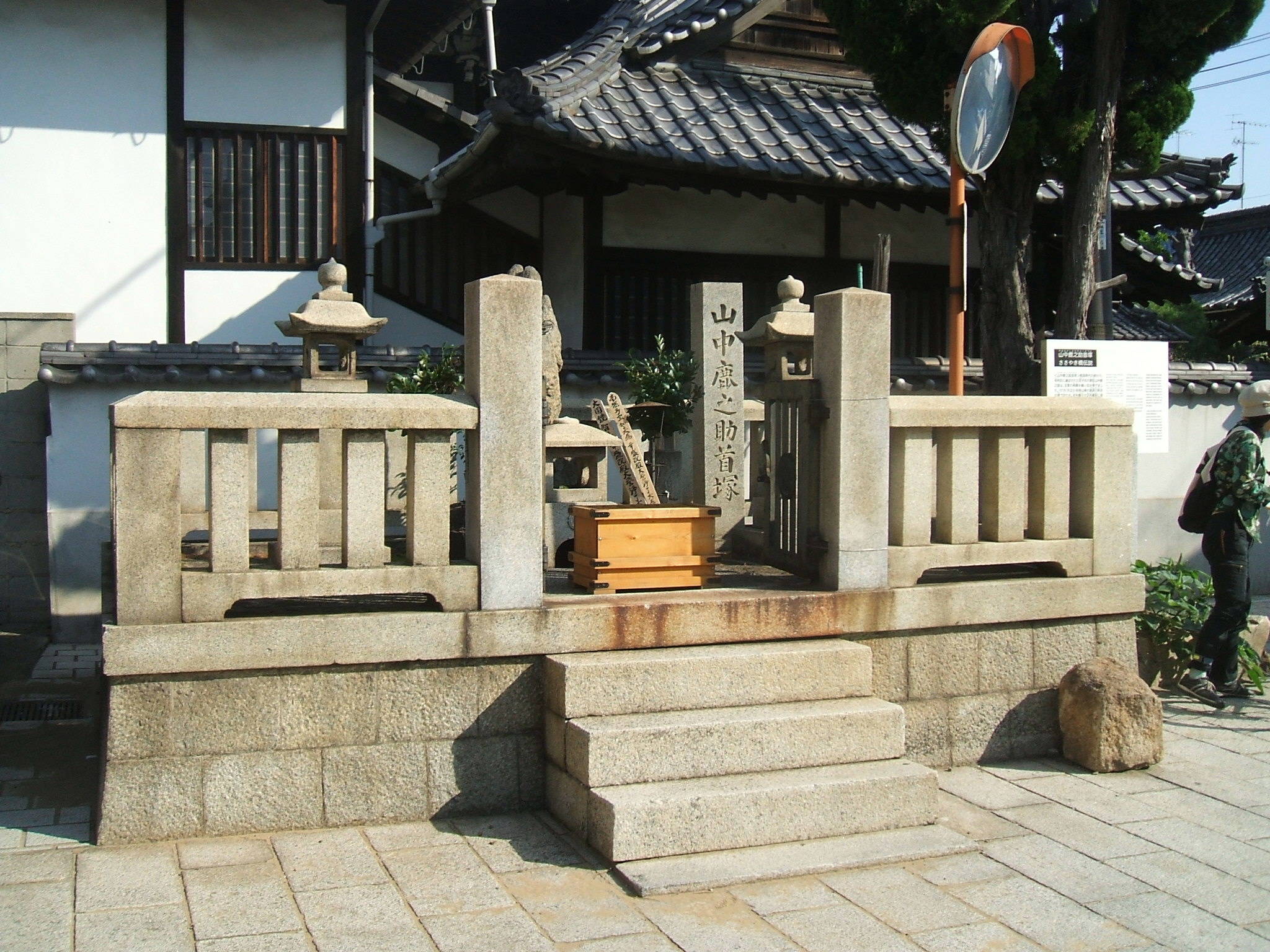
- Seikanji Temple Head Mound (Tomo-cho Gōchi, Fukuyama, Hiroshima Prefecture)**: It is said that Yukimori's head, after being inspected by Mōri Terumoto at Bichū Matsuyama Castle, was sent to this location. At the time, Ashikaga Yoshiaki was staying here under Mori protection, and the head was brought for his inspection. The monument is a natural stone with no inscription, but a marker stone nearby indicates "Yamanaka Shikanosuke Kubitsuka" (Head Mound). Yukimori's mortuary tablet is also enshrined within the temple, with the posthumous name "Kōshōin-dono Taiyo Jōryō Daikoji."